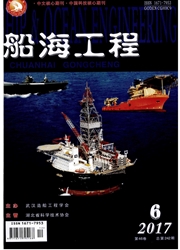

 中文摘要:
中文摘要:
为了准确计算风车安装船的站立稳定性,分别建立了不同约束下的风车安装船桩腿有限元模型,即传统铰支模型和桩土相互作用下的模型.利用这2种模型,从静力分析、模态分析和瞬态动力学分析方面对桩腿进行了数值模拟,并进行比较研究.研究结果表明:桩土相互作用模型的静力分析结果和铰支模型相差较大,其中最大应力都远低于桩腿屈服强度;2种模型下桩腿的固有频率略有差别,最大弯矩都发生在桩端处,未出现在水面附近;桩腿在变载荷下的最大位移偏大于静载荷下的最大位移.风车安装船桩腿结构具有优良的稳定性能;稳定性分析时采用桩土相互作用模型精度更高.
 英文摘要:
英文摘要:
To gain accurate calculation about standing stability of wind turbine installation vessel, two different constraint models of pipe legs, the conventional hinge model and the pile and soil interaction model, were established. With the two models, numerical analysis was conducted to investigate the standing stability of wind turbine installation vessel based on static, modal and transient dynamics analyses. The comparison results of two models show that the static analysis of the pile and soil interaction model is greatly different with that of the hinge model, while the two model maximum stresses are far below the yield strength of pile leg. The two natural frequencies of pile leg vary slightly, and the maximum bending moment occurs at the end of pile legs without occurrence near the water surface. The maximum displacement of legs under variable load is greater than that under static load. The pile leg of wind turbine installation vessel has good stability, and higher accuracy can be achieved by the pile and soil interaction mode to analyze stability.
 同期刊论文项目
同期刊论文项目
 同项目期刊论文
同项目期刊论文
 期刊信息
期刊信息
